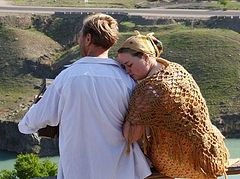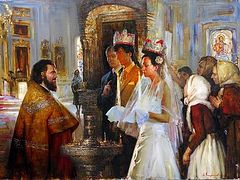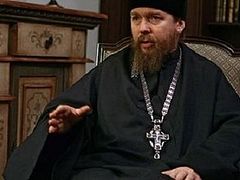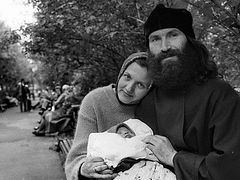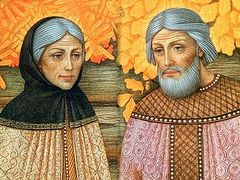 Statue of Sts. Peter and Febronia. Photo: Culture.ru
Statue of Sts. Peter and Febronia. Photo: Culture.ru
The “Tale of Peter and Febronia of Murom” was written by Monk Ermolai-Erasm (Ermolai Pregreshny), and the work immediately became a favorite read among the literate folk; it spread around in a huge number of handwritten copies, and was passed along in oral tradition. The complete text of the story is known to only a narrow field of specialists, but the story that entered into world history about their amazing love is remembered and retold to this day.
One day, Prince Peter was stricken with a terrible leprosy. All attempts to cure it were in vain—no one could help him. When the prince had reached the point of despair and had nearly given up, he had a significant dream: Peter saw that there lived a girl named Febronia, who was able to heal him.
Unlike Peter, who was the son of Prince Yuri of Murom, Febronia was from an ordinary peasant family. She lived with her father the beekeeper in the Ryazan village of Laskovo. From her early years she studied the properties of various plants and had the gift of healing. She was able to tame even wild animals, and they would obey her. This girl of remarkable beauty and kindness was pleasing to the young prince’s heart, and he gave his word to marry her as soon as he recovers. Febronia restored the prince’s health, but then he became fearful at the prospects of an unequal marriage, and didn’t keep his promise. Soon the same disease returned to Peter with renewed strength.
When Peter’s messengers again came to Febronia, she did not refused to help and again healed the young prince. Peter repented of breaking his promise, married his benefactress, and was happy with her to the end of his days. As tradition has it, the couple honored one another throughout their lives, and lived honestly, in peace and harmony.
After his older brother died, Peter ascended the princely throne. The boyars supported and respected the illustrious ruler, but they could not resign themselves to the fact that next to him on the throne sat a girl from the lower classes. The intelligent and beautiful Febronia gave no peace to the boyars’ wives’ envy. They tried to slander her and urged their husbands to wipe her off the face of the earth. One fine day the boyars gave Peter an ultimatum: either his rule, or his beloved wife. Peter abdicated the throne and left Murom together with his spouse.
Life in exile was not easy, but the wise princess never lost heart, always found a way out of a difficult situation, and supported her crestfallen husband. Peter never ceased to treat Febronia with great tenderness and never once reproached her with the fact that she was the cause of their exile.
Soon the Murom boyars understood that it was impossible for them to keep order in the city without their wise leader. Coming to their senses, they sent messengers to the princely couple to request that they return to head the government again. After taking counsel with his wife, Peter returned to his native land.
Thus did Peter and Febronia live together heart and soul to the gray temples of age, “praying without ceasing and showing mercy to all people under their authority, like a loving father and mother. They were equally loving to all, hated cruelty and greed, had no desire for corruptible wealth, but became rich in Godly treasures. And for their city they were true shepherds and not hirelings. They governed their city with fairness and meekness, and not with wrath. They gave hospitality to strangers, fed the hungry, clothed the naked, and delivered the poor from their misfortunes.”
In their old age the two received the monastic tonsure with the names Euphrosyne and David. Settling in different monasteries, they wrote letters to each other. They prayed to God that He grant them to die on the same day, so that together they might continue their on path to heaven. The couple even prepared a double coffin for themselves, in which their bodied would be separated by only a thin dividing wall. Tradition has it that their prayers were heard, and they reposed in the same hour on June 8/25, 1228. However, the couple’s will was not carried out—the two were buried separately. But then twice occurred something inexplicable, and their bodies turned up together in an unbelievable way. After that the clergy buried Peter and Febronia together near the Church of the Nativity of the Most Holy Theotokos.
Three hundred years after their death, Peter of Murom and his wife Febronia were ranked among the saints. The Orthodox calendar established July 8 as their commemoration day. In the 1990s, the citizens of Murom made that day their “city day”. Now the relics of Sts. Peter and Febronia are in one coffin, in the Holy Trinity Convent in the city of Murom. Thousands of pilgrims come to venerate them and ask for their heavenly intercessions. Falling down before their reliquary with faith, they receive healing.
In 2008, the Russian interfaith council made that day the day of family, love, and faithfulness. As the symbol of this day, they chose the daisy—a simple yet noble flower. There is also an opinion that the daisy is the flower of peacemaking. Soon a medal was created for this day, having on one side the image of Sts. Peter and Febronia, and on the other, a daisy. That is how they united the secular holiday with the Orthodox feast day, one supplementing the other. The tradition was established of awarding the medal to families in which a worthy emulation of love and mutual understanding reigns. The day of family, love, and faithfulness is celebrated in forty countries.
In 2008, outside the marriage registry office in Murom appeared the first monument to Sts. Peter and Febronia—“The union of love is a wise marriage”. In 2009, sculptural compositions began to appear in many Russian cities as part of the national “Family circle” program.
In 2012, the Holy Synod of the Russian Orthodox Church established another commemoration day of Sts. Peter and Febronia, celebrated on the Sunday preceding September 6/19, in memory of the translation of their honorable relics in 1992.
This decision was made due to the fact that the saint’s feast day of June 25/July 8 occurs during the Apostle’s fast, when the Church forbids the sacrament of weddings to be performed. Since many Orthodox Christians would like to have their wedding sacrament take place on the feast day of these two heavenly patrons of married couples, the question arose of assigning them an additional feast day outside of a Church fast period. Thus, as Sunday is not a fast day unless it falls during one of the four fasts periods, this date connected with September 19 was chosen—in memory of the day their relics were translated from the Annunciation Monastery to the Holy Trinity Convent,.
On the commemoration day of Sts. Peter and Febronia, as the Synod established, to the great ectenia is added special prayers about marriage:
· We pray also that Thy people would keep this commandment: what God has joined, let no man part, and may the churches of their homes be granted invincible strength and success in sincere love;
· We pray also for the preservation of Thy servants’ marriages in peace and oneness of mind, piety, and purity;
· We pray also that Thy people might be gladdened with the sight of sons and daughters, and that our people might multiply, and inherit Thy blessing from generation to generation.
From Culture.ru and Pravoslavie.ru
Translation by OrthoChristian.com

